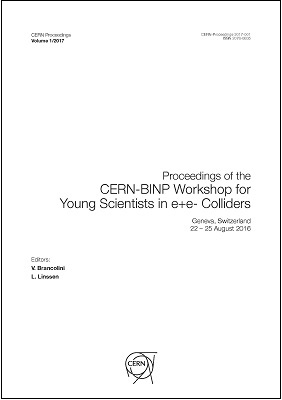GEM Detectors in the Experiments at e+e- Colliders in BINP
DOI:
https://doi.org/10.23727/CERN-Proceedings-2017-001.175Keywords:
KEDR experiment, DEUTERON facility, CMD-3 detector, Super $c-\tau$ Factory, Gas Electron Multiplier.Abstract
Micro-pattern gaseous detectors possess a high spatial resolution in tens micron scale together with high rate capability up to 107 cm-2s-1. In addition, they have all advantages of gaseous detectors, such as relatively low costs per unit area, the possibility to equip a large area as well as a high uniformity. Cascaded Gas Electron Multiplier (GEM) based detectors are used in the collider experiments at Budker Institute of Nuclear Physics (BINP), and they are being developed for a number of new projects. In this article the review of GEM based detectors for the tagging system of the KEDR experiment at the VEPP-4M collider and for the DEUTERON facility at the VEPP-3 storage ring is presented. The GEM detector application of the CMD-3 detector upgrade at the VEPP-2000 collider and the Super τ Factory detector are discussed.Downloads
Published
2017-06-29
Issue
Section
Submission to the proceedings of CERN-BINP Workshop for young scientists in e+e- colliders
License
Authors who publish with this journal agree to the following terms:- Authors retain copyright and grant the journal right of first publication with the work simultaneously licensed under a Creative Commons Attribution License CC-BY-4.0 (link to external page) that allows others to share the work with an acknowledgement of the work's authorship and initial publication in this journal.
- Authors are able to enter into separate, additional contractual arrangements for the non-exclusive distribution of the journal's published version of the work (e.g., post it to an institutional repository or publish it in a book), with an acknowledgement of its initial publication in this journal.
- Authors are permitted and encouraged to post their work online (e.g., in institutional repositories or on their website) prior to and during the submission process, as it can lead to productive exchanges, as well as earlier and greater citation of published work (See The Effect of Open Access).

